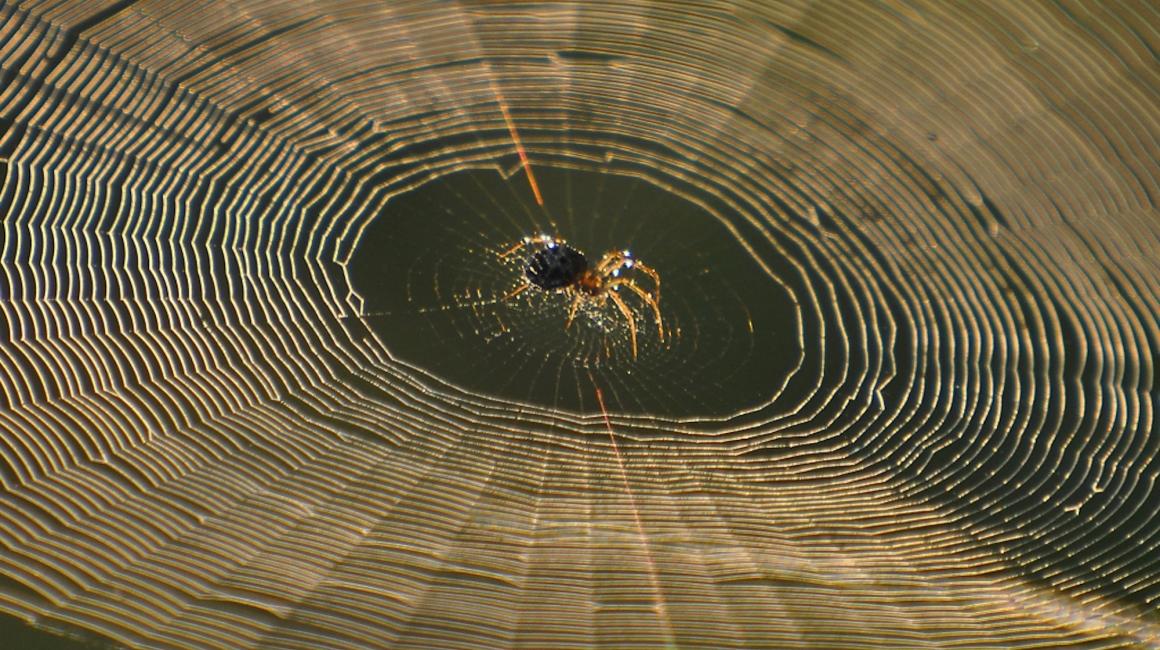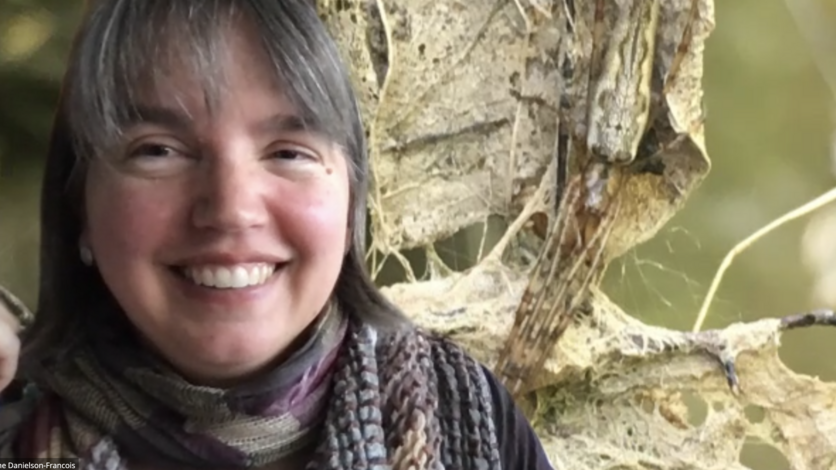
This article was originally published on October 27, 2021.
When people share photos of spiders in their home, responses vary from “I’d move out” to “just burn down the house.”
That reaction isn’t surprising with sci-fi horror movies featuring eight-legged stars, spooky spiders having a prominent role in Halloween decor, and knowing arachnids live in the deepest darkest places of pretty much any building.
Danielson-Francois has studied spiders for decades. She understands the fear — she once had it herself — but said it’s often misplaced.
“Yes, black widow and brown recluse spiders need some healthy respect, but you aren’t likely to see either of those around here,” said Biological Sciences Associate Professor Anne Danielson-Francois. “Often it’s the idea of the spiders that we are scared of...not the spiders themselves.”
She thanks her outdoorsy mother and education-focused father for dispelling her arachnid fear. After complaining about spiders to her parents, her dad encouraged her to learn more before judging them too harshly. That later led to a pet tarantula named Dracula, working with long-jawed spiders in graduate school, and continuing to study spiders almost daily.
Not everyone will gain that level of spider acceptance. But with Halloween right around the corner, Danielson-Francois shares a few spider benefits that might help us move beyond the fear and see that spiders really are pretty great house guests.

Spiders may help us unlock undiscovered scientific solutions.
When she is not doing spider fieldwork along the Rouge River in the summer, Danielson-Francois’ lab has approximately 300 live spiders to study. And if she finds an interesting spider crawling around campus, she’ll sometimes pick it up to share information about it with her class.
She’s used to having people question her about her interest in arachnids. She’s had calls from the New York Times, Reuters, USA Today and more. During her time as a graduate student at the University of Arizona, the lab she worked in was contacted to get information for the 2002 Spider-Man movie.
But her interest goes beyond spiders and how provocative they are. “Of course I think spiders are cool. Some are smaller than your thumb and make webs that are exquisite works of art — that’s amazing. But what I'm really interested in is studying evolution and behavior. I’m using spiders to do that,” she said. Spiders, which existed approximately 150 million years before dinosaurs, are thought to be one of the first animals to live on land.
In addition, studying spider evolution and behavior may lead to other discoveries. Danielson-Francois said scientific advances sometimes come from unlikely places.
For example, a brain tumor “paint” that lights up cancer cells came from knowledge gathered by researchers studying scorpions, a member of the arachnid family that fluoresces under UV light. And looking at spider research, robots that need to navigate difficult terrain are being built based on how spiders move.
Spiders' eating habits have known benefits for humans.
Spiders don’t want anything to do with you. Instead, their energy is spent on catching their next meal, which helps you get rid of pests. All free of change.
Some of the insects they exterminate are potentially harmful insects like bed bugs, kissing bugs or mosquitoes. Danielson-Francois said studies have shown spiders are good biological control agents — where there are more spiders, there is a lower incidence of malaria. There are even specific spiders that prefer to eat mosquitoes that are carrying the malaria parasite.
Spiders also play a huge part in our ecosystem and snack on insects, like grasshoppers, beetles and mealybugs, that feast on crops. Spiders get rid of the moths that eat through clothing and fabric. Some spiders — the funnel weaver that creates a gauzy-looking web — will even devour ants.
“Spiders are giving you natural pest control,” Danielson-Francois said. “Orb weavers, those are the spiders everyone is noticing right now because they are at maturity and males are out looking for females. They eat flying insects — taking care of flies, mosquitos, moths and more by the thousands.”
Studying spiders can help prepare students who want to work in the medical field.
Over the past decade, Danielson-Francois and her research students have observed and cared for different species of orbweaving spiders. She said that some of her students are apprehensive at first — but after working with the spiders, they see them differently. “It’s just like anything else. The more you learn and interact with them, the less afraid you are,” she said. “Sometimes our spiders do get accidentally squished or break a leg — they are very fragile — and our students feel badly about that. They get so attached to them.”
Many of her students continue on to master’s and Ph.D. programs, Danielson-Francois said. And some of her lab students are pre-med. During her 14 years on campus, several have gone on to be doctors, dentists and other healthcare professionals. She said spider research provides technical skills — like data analysis, dissection techniques, meticulous labeling and handling of specimens, critical thinking and proper biological identification — that easily transfer to the medical field.
There’s also the added benefit of knowing spider specifics. “People go to the doctor and the Emergency Room with a ‘spider bite.’ Most are harmless or actually caused by insects and not spiders. The experiences my students have will help them identify medically important spider species and what treatment is needed, if any.”
She said the research gives students an opportunity to do research in a lab and get published — something medical schools look for in the admissions process. Humayra (Myra) Nikhat Sullivan, the co-author on Danielson Francois recently published research on the long-jawed spider, is a UM-Dearborn alumna who's doing her residency at Michigan Medicine.
Their work examined why the long-jawed orbweaver’s jaws are twice as long as other orbweaving spiders. Observing the spiders, Danielson-Francois and Myra Sullivan discovered it mainly has to do with mating behavior — the long jaws interlock in an embrace during mating, a unique feature to these spiders. The research on function continues with additional students in the lab.
In many cultures, spiders are a symbol of good luck.
If medical discoveries, intellectual advancement and pest control haven’t won you over — just err on the side of caution.
Spiders live on every continent except Antarctica and many cultures feel it’s bad luck to kill a spider. The English see one of their common spiders, the Linyphiidae or money spider, as a sign of wealth. If you eliminate it from your home, your financial prospects go with it.
“Different cultures respect spiders differently than we do. Many cultures see a spider in their home as a positive thing. We fear spiders here and pass it onto the next generation. Kids learn this early on — it’s something my daughter picked up in school. I had to counteract that message right away.”
To help the fear go away, education is key.
Danielson-Francois shared two free resources that can help with identification: the mobile app Seek by iNaturalist and the website BugGuide.net. ”Once you know what you are looking at, its behaviors and benefits, spiders aren’t so scary,” she said. “Some are really fascinating. You might find yourself wanting to learn more. Look up the dancing peacock spider — you won’t be disappointed.”
Article by Sarah Tuxbury. If you’re a member of the media and would like to interview Danielson-Francois about this topic, give us a shout at [email protected] and we’ll put you in touch.


